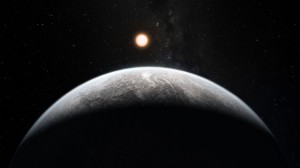[NOTE: I have been informed that this is NOT the first planet seen in the habitable zone of another star, but the first seen by Kepler, and moreover the first that is not a gas giant. Rather than try to correct the text below using strikethroughs, which would be confusing, I simply edited the text. I hope that’s clear!]
 This is pretty big news: the space-based Kepler observatory has confirmed it has found its first planet in the habitable zone of a star like the Sun! Not only that, the planet may well be similar to Earth, though that’s not clear yet.
This is pretty big news: the space-based Kepler observatory has confirmed it has found its first planet in the habitable zone of a star like the Sun! Not only that, the planet may well be similar to Earth, though that’s not clear yet.
The planet, called Kepler-22b, is about 600 light years away. The star it orbits, called simply Kepler-22, is a bit lower mass and cooler than the Sun. The planet takes about 290 days to circle the star once, and as soon as I saw that number I let out a little “yip” of surprise – that number’s perfect! Why?
Because that puts the planet inside of that star’s habitable zone, the distance where, given certain planetary conditions, liquid water can exist. It may be that life can arise where there’s no water, but we know life on Earth needs water, so if we’re looking for habitable planets it makes sense to look for the possibility of water there.
The planet is closer to its star than Earth is to the Sun – that’s why its year is shorter – but the star is cooler, compensating for that. That makes this the best candidate yet for Earth-like conditions. But is the planet like our own world?
That’s hard to say.
Kepler detects planets when they transit their star, passing directly in front of the star, blocking its light a little bit. The bigger the planet, the more light it blocks. The astronomers going over the data determined that Kepler-22b is about 2.4 times the diameter of the Earth. The problem is, that and its distance from its star are all we know. We don’t know if it’s a rocky world, a gaseous one, or what. It may not even have an atmosphere!
So we can’t say what conditions are really like on the planet. As you can see on the diagram above (click to embiggen), mass and atmosphere make a difference! Venus and Mars are both technically inside the Sun’s habitable region, but Venus’s thick atmosphere makes it hotter than an oven, and Mars’s thin air makes it colder than a freezer (if we could swap those two, though, then things would get pretty interesting in the solar system). Kepler-22b might be a paradise, or it might be the opposite. That depends in part on the planet’s gravity, and for that you need its mass.
The problem is we don’t know the planet’s mass. Kepler’s transit technique doesn’t find that; it has to be determined using very tricky observations of the planet’s gravity as it tugs on its star. Since Kepler-22b’s orbit is 290 days long, that makes this kind of observation much harder (the closer in the planet, the harder it pulls on the star, and the bigger the signal… plus you don’t have to wait as long for it to go around once). In fact, that’s why it took so long to confirm this planet’s existence – you need three transits for that! The first transit took place coincidentally just a few days after Kepler was launched in space, but the planet had to pass in front of its star a second time 290 days later to make sure the dip in starlight was real, and then a third time 290 days after that to confirm the period.
Now we might speculate that the planet is similar in composition to Earth – rock and metal and water. If so, then it has more gravity than Earth. Standing on its surface (assuming it has one) you’d weigh 2.4 times what you do on Earth! So even if it looks like Earth, it won’t be too much like it. On the other hand, if it’s made of lighter materials, the gravity could be lower. We just don’t know yet.
But that doesn’t diminish the fact that this planet exists at all! We’ve found a relatively low mass planet orbiting its star at the right distance for Earth-like conditions to arise. That’s very exciting! We’ve been closing in on this for a while now, finding lower mass planets that are too close in (though getting close to their star’s habitable zone), or bigger planets (like Jupiter) at about the right distance. This is the first confirmed planet that’s at the right distance and may have the right mass to be considered Earth-like.
Right now, as far as we know, Earth is still the only planet in the whole galaxy that has life, or even the exact right conditions for life. But what observations like this tell us is that there are more planets out there, a huge variety of them. This means the odds get better every day that – for some planets at least – the characteristics all come together to make them look an awful lot like us. The day is getting closer when we find that first planet. It’s just a matter of time, and the diligent work of astronomers like those who found Kepler-22b.
Image credits: ESO/M. Kornmesser; NASA/Ames/JPL-Caltech
Related posts:
- How many habitable planets are there in the galaxy?
- A boiling superEarth joins the exoplanet roster
- New study: 1/3 of Sun-like stars might have terrestrial planets in their habitable zones
- 50 new worlds join the exoplanet list